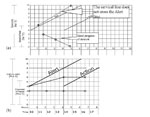9.3.3 Evidence from the partograph
You will remember from Study Session 4 that the partograph is a key tool in detecting an abnormal or prolonged labour. Obstructed labour is revealed by recordings on the partograph of the rate of cervical dilatation (which, as you know, should progress at a rate of at least 1 cm per hour) and the rate of fetal head descent. Figure 9.3(a) shows a partograph record of a normal labour with progressive cervical dilatation and fetal head descent. However in Figure 9.3(b) you can quickly see that there is evidence of a prolonged first or second stage of labour because:
- the cervical dilatation measurement has crossed the ‘Alert line’ and if no action is taken it will cross the Action line, despite strong uterine contractions; the fetal head is not descending.

![]() The cervical dilation record on the partograph should not cross the Alert and/or Action line. If this occurs you should consider this to be a prolonged and possibly obstructed labour and make an urgent referral.
The cervical dilation record on the partograph should not cross the Alert and/or Action line. If this occurs you should consider this to be a prolonged and possibly obstructed labour and make an urgent referral.
In Figure 9.3(b), how many hours after recordings began on the partograph did cervical dilation stop progressing?
The cervix stopped dilating 4 hours after the partograph record began.
In the partograph shown in Figure 9.3(b), how much time has passed since there was any sign of cervical dilatation?
The partograph shows that there was no increase in cervical diameter for the previous two and a half hours.
9.3.2 Bandl’s ring
